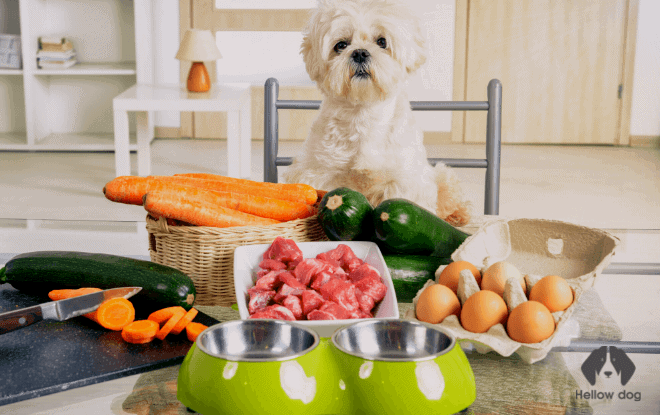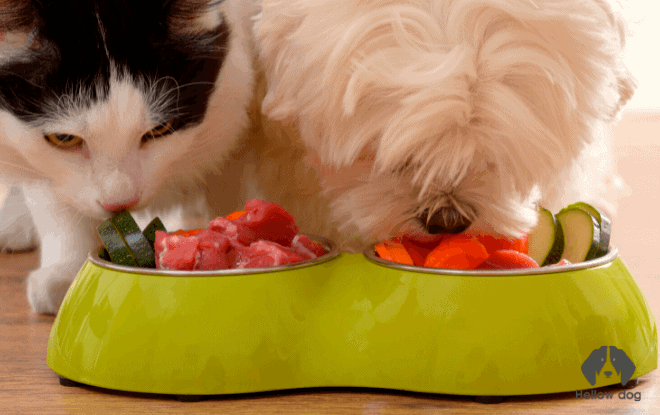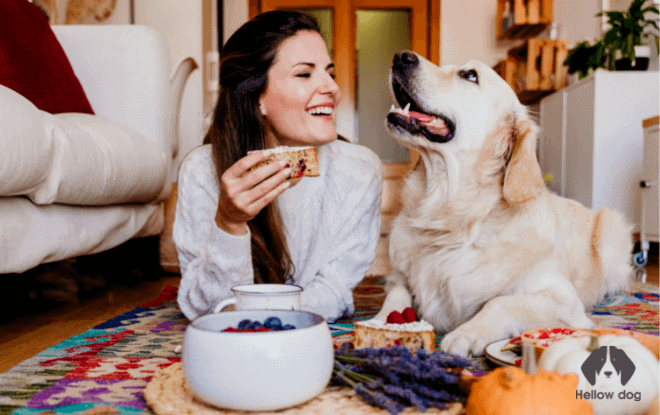When it comes to our canine companions, we want to do everything to ensure they’re as healthy and happy as possible. This means feeding them the best food we can find, ensuring they get enough exercise, and providing them with plenty of love and attention. But sometimes, even with our best efforts, our dogs can start to put on a few extra pounds or not have their nutritional needs met. So if your dog is a little too chubby, lacking in energy, or dealing with allergies, it may be time to consider homemade dog food as an option.
In this article, we’ll discuss the pros and cons of homemade dog food, as well as some essential ingredients and nutrients and high quality dog supplies that your pup needs to be healthy. We’ll also provide you with some essential tips for ensuring that your dog maintains a healthy weight. But before we dive into that, let’s take a little walk down history lane. So grab your dog, their leash, and let’s go.

The Rise of Commercial Dog Food
Up until the mid-1800s, dogs were basically eating leftovers, table scraps, and other bits of food unfit for people to consume.
This might be hard to believe, given the massive variety of commercial dog food brands available today. But the truth is, these food companies only appeared in the mid-20th century. Many dogs did pretty well on this assortment of food which was, to be honest, probably a lot healthier than what many folks are eating today. This is because there were no pre-packaged processed, sugar- and sodium-spiked foods like we have today. So, in this way, dogs got what they needed nutritionally in the same way people did.
This all changed in the 1860s when an American named James Spratt was motivated to make and sell shelf-stable dog biscuits made from wheat, vegetables, beets, and meat. His inspiration? Watching dogs in London eat hardtack, a tough biscuit-like cracker eaten by sailors while journeying at sea. He eventually took his idea back to the USA, and dog owners delighted as more options became available over the years.
The early 20th century saw the advent of canned dog food. But the wars meant tin was in short supply, so dry dog food became the go-to once more. The post-war 1950s saw the establishment of many commercial pet food giants that we know today. Convenience for owners, TV advertising, and supermarket availability entrenched dry dog food into the daily lives of many. However, there’s been a surge in dry dog food alternatives in recent years, including raw food diets, dehydrated and freeze-dried food, and, of course, simple homemade dog food.

A Return to Homemade Dog Food
As people choose to eat simpler and cleaner, those with dogs are opting for cleaner and healthier diets for their pets. This trend will only continue to grow over time. We can see its impact as boutique brands pop up, offering “homemade” food delivery and big brands trying desperately to adjust to public sentiment. We see more and more commercials and campaigns from companies touting the health benefits of dog food made with natural ingredients and no chemicals, artificial flavors, or preservatives. It’s all about better-quality options for dogs these days. Lucky them!
The Pros, Cons, and Myths of Homemade Dog Food
When it comes to homemade dog food, there is a lot of information to take in. And while you are deciding what’s best for your dog, many others are, too. This is why it’s essential to get all your facts straight in terms of what’s best for your dog.
The Pros of Homemade Dog Food
- Fresh Food – Dogs thrive on fresh foods as people do. By switching to homemade food, you’ll be giving your dog all the benefits that you get when your diet is full of fresh veggies, fruits, and meats. Some potential benefits of eating a fresh food diet include better health, increased energy, and improved eagerness for mealtime because the flavors will be top-notch. That’s why homemade dog food is excellent for eager and picky eaters alike.
- No Filler Ingredients – Most commercially prepared dog foods have a lot of filler ingredients. Usually something cheap that is high in calories but not very nutritious. They do this to bulk out their foods and drive up profits. Not all of them are bad, but not all are great, either. With homemade food, you can avoid this by adding high-quality protein, fats, and carbohydrates in proper ratios that will keep your dog feeling full without the use of fillers.
- More Variety – Since you’re in control of the menu, you can offer your dog a wider variety of food and avoid having to limit them to whatever’s in the kibble you feed them. You can change up proteins, find the ones that they do best on, and offer various flavors to keep them happy, interested, and excited at every meal.
- Less Waste – When cooking for yourself, you can set aside unused bits or leftovers for your pet. Waste is lessened in this way, so you can avoid tossing out scraps that you can incorporate into your dog’s food instead. For example, you can use chicken or beef bones by boiling them and creating a tasty bone broth. And your dog won’t care if they get the carrot ends you’d normally toss in the compost bin.
- Allergy Control – Dogs have allergies and sensitivities to various foods just like people. Cooking their food from scratch means that you know what’s in each meal and can avoid ingredients that might be making them sick or trigger their allergies. This is also great when trying to pinpoint ingredients that your dog doesn’t do well with. For example, if you notice your pup is scratching excessively after a week of food that includes beef or gluten, you can take them off the menu and see if that helps.
- Quality Control – When you make your dog’s food, you’ll be sure that it’s free of preservatives, artificial flavors, and colors. You can even opt to go organic with your produce or grass-fed and free-range with your protein. This ensures that your dog is eating real food that’s healthy and safe. You can also select the exact cuts of meat and produce items that make their way into your dog’s food bowl. So, in the same way you choose the best quality products when cooking for your family, you can now do the same for your dog and include them in the love.
The Cons of Homemade Dog Food
- Time – Preparing food for another mouth to feed can be a considerable time commitment, especially with so much else taking up the few precious hours we have each day. Sure, as time goes on, you’ll probably become more efficient. But having to cook and take care of another being is not easy for everyone.
- Dangerous Ingredients – Is human food toxic to dogs? The truth is, there are a lot of foods that a dog should never eat. Some of these are obvious or well-known like alcohol, caffeine, and chocolate. However, ingredients you might include in your own meals could prove hazardous to your dog. Steer clear of onions, garlic, and chives to start. Macadamia nuts and grapes and raisins are also a danger. When in doubt, don’t risk it. But also stay vigilant and aware of what’s going into the food you’re preparing.
- Nutritional Deficiencies – Dogs need protein, fat, carbohydrates, vitamins, minerals, and water. You can provide these through recipes that you whip up, but it’s important to do your research first. Some ingredients will provide more nutritional value than others, as with people food. And remember, dogs have different dietary needs from people. So even if you know what you need, it’ll be different for your dog.
- Balancing Calories and Fullness – You need to take care to feed your dog enough calories to meet their needs, but not too many, while also ensuring they don’t feel hungry. This is a tricky balance to maintain and often requires research and outside help. There’s a reason why dry kibble has recommended serving sizes on the bag. Now it’s time to make your own, which could vary depending on what you make.
- Culinary Capabilities – Though you might feel inspired to cook an excellent meal for your dog once in a while, are you up to taking on the task regularly? You don’t have to be a trained chef, but you must have the proper motivation and knowledge to prepare tasty, safe food.
- Inconvenient – Homemade dog food is all nice and dandy when you’re at home. But what about when you travel with your dog, your dog boards at a kennel, or if you want to go on a day trip? You’ll need to prepare enough food for them and ensure it’s packed in a way to ensure freshness and prevent spoilage.

Myths of Homemade Dog Food Debunked
- Its Super Expensive – Many people are led to believe that feeding their dog a homemade diet will be prohibitively expensive, and they shouldn’t even try. The truth is, just like when it comes to healthy eating for humans, there are choices to be made and strategies to make it as or even more cost-effective than dry kibble diets. Methods to lower the costs include:
- Buying in bulk
- Meal planning before shopping
- Shopping the weekly sales
- Taking advantage of generic or store brands
- Only making the food you need to prevent waste
- It’s Not Safe – Derived from a lack of knowledge or proper information, myths about homemade dog food abound. Rumors of pets becoming sick or worse because of homemade dog food are often passed off as truth, especially by those who profit from the pet food industry. The reality is that most of the time, these cases stem from poor information, such as making food without proper knowledge, leading to using improper or imbalanced ingredients.
- Variety Means No Need for Supplements – Even if you do all the research you possibly can, many qualified vets will still encourage you to provide a supplement when you’re working to create a complete and balanced homemade diet. They do this to be extra safe and meet the unique needs of each dog. For example, high-quality omega 3 supplements like salmon oil for dogs can be added to meals. You can also go the route of a dog multivitamin, which often comes in a tasty chew that most pups happily gobble up.
- Dogs Eat Like People Do – Yes, humans and dogs are omnivores. However, dogs aren’t quite as omnivorous as humans. This means their bodies aren’t as equipped to handle veggies and fruit in the exact quantities as ours. Therefore, you’ll need to work on ratios and ensure you include enough meat-based proteins and other nutrients your pup needs.
Essential Foods and Nutrients for Your Recipes
Like many who’ve started feeding a homemade food diet, your recipes will evolve and change over time. What works for your dog today could become dull or need to be tweaked tomorrow. The following are some general guidelines about the primary food groups and nutrients you should include as staples in your homemade dog food recipes:
- Protein – This is a necessary component of a dog’s diet and should be around 40 percent of their food. Protein provides dogs with essential amino acids that they can’t produce in their bodies, which are necessary for energy. Some popular sources of protein include:
- Fats – Fats are needed because they provide fatty acids like that omega 3 you hear so much about. They can come from either animal sources but also plant-based oils. Fatty acids are required for cell function and structure and skin and coat health. They’re also great for improving food flavor, making it more appealing to dogs. Dogs will need a bare minimum of around 6 percent fat calories but can go up to 25 percent. This varies by breed, age, activity level, and health status.
- Carbohydrates – You’ll find these in vegetables or grains, which your dog can eat as long as they’re cooked. Dogs are great at digesting starches, which means they can get a lot of energy from these foods. However, too many carbs can lead to obesity. While veggies can account for up to 50 percent of their diet, starches should only make up 10 percent of their diet.
- Fiber – Found in vegetables and grains, fiber is great for a healthy digestive tract and bringing balance to your dog’s blood sugar levels.
- Vitamins and Minerals – Dogs get the vast majority of their vitamins from the meat and veggies in their diets. However, adding all-natural dog supplements to the mix will ensure your pup gets all the nutrients they need.

Tips to Ensure Proper Food Intake and Healthy Weight
It’s easy to get into a routine for your dog to feed them according to their age, breed, and weight. While this can be helpful when it comes to shedding pounds or maintaining a healthy body mass index (BMI), you’ll still want to check in with your vet and adjust accordingly.
- Number of Meals Per Day – While having a lot of certain nutrients can be beneficial, it’s important to remember that too much of a good thing isn’t such great news. For example, some homemade dog food recipes include lots of veggies, but too many may lead to gas and bloating. While it’s not the end of the world for your pup, it’s also not the most pleasant experience for them to deal with. As such, feeding your dog twice a day is often best to avoid this issue or any other related to having too much food at once.
- Portion Size – Another way to ensure your dog stays healthy is to watch their portion size. At first, you may give your pup more than you think they should have but could soon find out that the meal sizes you used were too large when they start rounding out and packing on the pounds. Portion sizes will also change according to the proteins and fats you use, so what works today for an amount may not be tomorrow.
- Keep It Interesting – By switching up the ingredients in your dog’s food, you can help them stay engaged and interested in their food and mealtime. In addition, rotating between protein sources helps avoid getting sick of any kind. And if you mix up a batch only to find your dog doesn’t like certain ingredients, try mixing in another tried and tested favorite.
- Ingredient Quality – It might be tempting to use sub-par ingredients to save a little, but if you do, your dog’s health could suffer as a result. Always give your dog the best food quality you can get your hands on.
- Work with a Professional – Our last tip is possibly the most important of all, and that’s to work with a vet or qualified animal nutritionist when crafting your dog’s new diet. This way, you can get everything right, including the proper ingredients and portion sizes.
By taking care of your dog’s needs from a nutritional perspective, you can give them a better quality of life and ensure they stay healthy for as long as possible.

